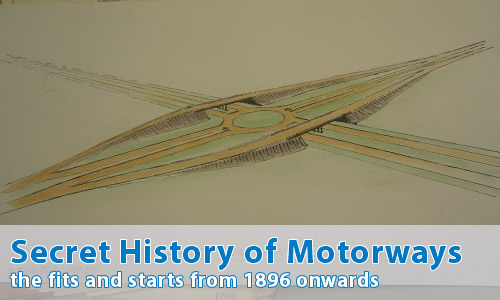The Motorway Age: 1959 - 1968
The excitement felt by the country at this progress towards the future is almost impossible for us to comprehend today. The late 1950s and the 1960s were a time for thinking of the future - the future was where it was going to be and the past was, well, gone. Motorways tapped into this feeling, and for a while it must have seemed like anything was possible.
There is a story that the Preston Bypass jammed up almost instantly, simply with people wanting to see this new motorway, and for the first few days either end saw huge delays as motorists struggled to get off the bypass, after having sped from one end to the other at a rate of knots! Bus tours were run up and down the M1, and motor manufacturers like Jaguar used it to test out their vehicles in pre-speed limit days.
It really does sound like a different world.
By August 1962, there had been plenty of work undertaken. The first motorway outside England, a 6 mile section of Northern Ireland's M1 had just opened, along with parts of M5 and the entire M50 to add to the long distance network, with a whole bunch of motorway bypasses including Maidstone, Maidenhead, Doncaster, Stevenage, Lancaster and Stretford-Eccles, with the M6 bypasses of Stafford and Newcastle-under-Lyme almost ready to open. It was then that Ernest Marples, the Minister of Transport, had a big announcement. It was to become policy to complete 1,000 miles of motorway by the early 1970s.
As usual, the devil was in the detail, and in this case, there was no detail. Still, that wasn't to stop the relentless march of progress, was it?
Meanwhile, the first Scottish motorway (the M8 Harthill Bypass between junctions 4 and 5) opened in November 1965, and the first Welsh motorway (the A48(M) Port Talbot Bypass) joined it in July 1966.
Motorways, of course, don't just have to be large roads running between cities - they can also be used within urban areas too. To that end, several towns and cities started thinking in that general direction, with perhaps the 1962 SELNEC Highways Plan being the most comprehensive. The Highways Plan looked at the entire Manchester/Salford conurbation, and was a joint study between all of the local authorities in the area. Perhaps not surprisingly, it recommended a complete network of urban motorways - and it's the reason why that part of the world has one of the most dense motorway networks in the country, even if large parts of the Highways Plan never saw the light of day.
Other areas to come up with their own plans included Tyneside, Glasgow, Liverpool and perhaps most famously of all, London.
With all this construction going on, a long hard look had to be taken at how the process was organised. Six Road Construction Units came into being, regionally based in England, with London having its own arrangements. RCUs were generally staffed by individuals "on loan" from the County Councils within, so there was generally a good relationship between all the bodies concerned, which only helped the entire process along.
By the end of 1968, some 72 individual stretches of motorway had been opened, with plenty more in the pipeline. It looked as if the 1,000 mile target would be easily achieved.

